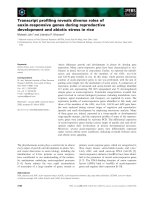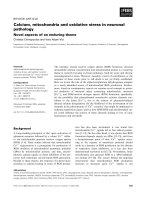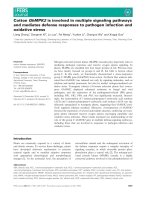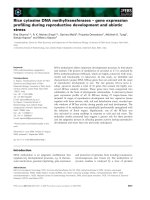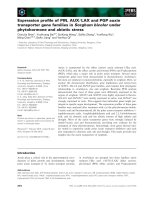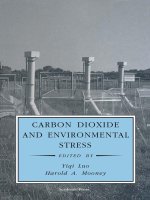COMBINED BENDING AND DIRECT STRESS
Bạn đang xem bản rút gọn của tài liệu. Xem và tải ngay bản đầy đủ của tài liệu tại đây (325.35 KB, 12 trang )
12
Bending stresses and direct stresses
corn
bined
12.1 Introduction
Many
instances arise in practice where a member undergoes bending combined with a thrust or
pull. If a member carries a thrust, direct longitudinal stresses are set up; if a bending moment is
now superimposed on the member at some section, additional longitudinal stresses are induced.
In
this
chapter we shall be concerned with the combined bending and thrust of short stocky
members; in such cases the presence of a thrust does not lead to overall instability of the member.
Buckling of beams under end thrust is discussed later in Chapter 18.
12.2
Combined bending and thrust
of
a stocky strut
Consider a short column of rectangular cross-section, Figure 17 l(i). The column carries an axial
compressive load
P,
together with bending moment
M,
at some section, applied about the
centroidal axis
Cx.
(1)
(11)
(111)
(IV)
Figure
12.1
Combined bending
and
thrust
of
a rectangular cross-section
beam.
The area of the column is
A,
and
I,
is the second moment
of
the area about
Cx.
If
P
acts alone,
the average longitudinal stress over the section
is
P
A
the stress being compressive. If the couple M acts alone, and if the material remains elastic, the
284
longitudinal stress in any fibre a distance y from
Cx
is
Bending stresses and direct stresses
combined
w
I,
for positive values of y. We assume now that the combined effect of the thrust and the bending
moment is the sum of the separate effects of
P
and
M.
The stresses due to
P
and
M
acting
separately are shown in Figure 12.l(iii) and (iv).
On
combining the
two
stress systems, the
resultant stress in any fibre is
(12.1)
(r
=
PMY
A
I,
Clearly the greatest compressive stress occurs in the upper extreme fibres, and has the value
P
Mh
A
25
(12.2)
-
omax
-
-
-
In
the lower fibres of the beamy is negative; in the extreme lower fibres
PMh
A
2Zr
(12.3)
(r
=
+-
which is compressive or tensile depending upon whether
(Mh/21,)
is less than or greater than
(PIA).
The
two
possible types of stress distribution are shown
in
Figure 12.2(i) and
(ii).
When
(Mh/zI,)
<
(P/A),
the stresses are compressive for all parts of the cross-section, Figure 12.2(1). When
(MW2ZX)
>
(P/A),
the stress is zero at a distance
(PZJAM)
below the centre line of the beam, Figure
122(ii);
this
defines the position of the neutral axis of the column,
or
the axis of zero strain.
In
Figure 12.2(i) the imaginary neutral axis is also a distance
(PZJAM)
from the centre line, but it lies
outside the cross-section.
1'1
Figure
12.2
Position
of
the neutral axis
for
combined bending and
thrust.
Eccentric
thrust
285
12.3
Eccentric thrust
We can use the analysis of Section 12.2 to find the stresses due to the eccentric thrust. The column
of rectangular cross-section shown in Figure 12.3(i) cames a thrust
P,
which can be regarded as
concentrated at
tk-
point
D,
whch lies on the centroidal axis
Cy,
at a distance
ev
from
C,
Figure
12.3(ii). The eccentric load
P
is statically equivalent to an axial thrust
P
and a bending moment
Pe,
applied about
Cx,
Figure 12.3(iii). Then, from equation (12. l), the longitudinal stress any fibre
is
A
eyY
(12.4)
c
=
P
PeyY
- -
-p(I-T)
A
4
A
I
I
w-b-
I
I
Figure
12.3
Column
of
rectangular cross-section carrying
an
eccentric
thrust.
We are interested frequently in the condition that
no
tensile stresses occur in the column;
clearly, tensile stresses are most likely to occur in the lowest extreme fibres, where
0
=
-E[l-$?)
A
(12.5)
This
stress is tensile if
Aeyh
->
1
(12.6)
21,
that is, if
6eY
->
1
h
or
(12.7)
1
6
e,,
=
-h
286
Bending stresses and direct stresses combined
Now suppose the thrust
P
is applied eccentrically about both centroidal axes, at a distance
e,
from the axis
Cy
and a distance
e,
from the axis
Cx,
Figure
12.4.
We replace the eccentric thrust
P
by an axial thrust
P
at
C,
together with couples
Pe,
and
Pe,
about
Cx
and
Cy,
respectively.
Figure
12.4
Core of
a
rectangular cross-section.
Figure
12.5
Core
of
a circular cross-section.
The resultant compressive stress at any fibre defined by co-ordinate
(x,
y)
is
P Pe,x pe.”Y
A
’”
I*
(r
=
-_
-
(12.8)
=
1+-+Y
P
[
A;x
iri]
A
1,
Suppose
e,
and
e,
are both positive; then a tensile stress is more llkely to occur at the comer
B
of
the rectangle. The stress at
B
is tensile when
Ae,b Ae,h
1
.
<o
(12.9)
21”
21,
On substituting for
A,
I,
and
I,,,
this becomes
6ex 6e
h
h
1
‘<O
(12.10)
If
P
is applied at a point on the side of the line
HG
remote from
C,
this inequality is satisfied, and
the stress at
B
becomes tensile, regardless of the value of
P.
Similarly, the lines
HJ, JF
and
FG
define limits on the point of application of
P
for the development of tensile stresses at the other
Eccentric thrust
287
three comers of the column. Clearly, if
no
tensile stresses are to be induced at all, the load
P
must
not be applied outside the parallelogram
FGHJ
in Figure 12.4; the region
FGHJ
is
known
as the
core
ofthe
section.
For the rectangular section of Figure 12.4 the core is a parallelogram with
diagonals of lengths
V3h
and
%b.
For a column with a circular cross-section
of
radius
R,
Figure 12.5, the tensile stress is most
likely to develop at a point
B
on the perimeter diametrically opposed to the point
of
application
of
P.
The stress at
B
is
(r
=
++
P PeR
- -
y1
-7)
(12.11)
A
I
A
where
I
is the second moment
of
area about a diameter. Tensile stresses are developed if
(12.12)
-
AeR
>
1
I
On substituting for
A
and
I,
this becomes
4e
->
1
R
or
R
4
e>-
(12.13)
The core of the section is then a circle
of
radius
%R.
Problem
12.1
Find the maximum stress on the section
AB
of
the clamp when a pressure
of
2500 N is exerted by the screw. The section is rectangular 2.5 cm by
1
cm.
(Cam
bridge)
Solution
The section
AB
is subjected to a tension
of
2500 N, and a bending moment (2500)(0.10)
=
250
Nm. The area
of
the section
=
0.25
x
lO-3
m2. The direct tensile stress
=
(2500)/(0.25
x
lO-3)
=
10 MN/m2. The second moment
of
area
=
1/12 (0.01)(0.025)3
=
13.02
x
lO-9
m'.
Therefore, the maximum bending stresses due to the couple of 250 Nm are equal to
288
Bending
stresses
and
direct stresses combined
(250)(0*0125)
=
240
mlm2
(13.02
x
10-9)
Hence the maximum tensile
stress
on
the section is
(240
+
10)
=
250 MN/m2
The maximum compressive stress is
(240
-
10)
=
230 MN/m2
Problem
12.2
A
masonry
pier has a cross-section 3
m
by
2
m,
and is subjected to a load
of
1000
kN,
the line
of
the resultant being 1.80 m from one
of
the shorter sides,
and 0.85 m from one of the longer sides. Find the maximum tensile and
compressive stresses produced.
(Cambridge)
Solution
P
represents the line
of
action of the
thrust.
The bending moments are
(0.15)(1000
x
IO3)
=
150 kNm about
OX
(0.30)(1000
x
lo3)
=
300
kNm about
OY
Now,
1
12
1
12
Z,
=
-
(3)(2)3
=
2 m4
1,
=
-
(2)(3)3
=
4.5 m4
The cross-sectional area
is
A
=
(3)(2)
=
6
m2
Prestressed concrete beams
289
For a point whose co-ordinates are
(x,
y)
the compressive stress is
+x+-
Ae
ZY
x
Aevy)
1,
(r
=
-‘(l
A
1
+-+”)
2.5
20
(x
cB
=
-106
(
1
+
5
3
+
x)
=
-0.342
m/m2
which gives
1000
x
103
o=-
6
The compressive stress is a maximum at
B,
where x
=
1.5 m and
y
=
1
m. Then
6
20
ThestressatD,wherex
=
-1Smandy
=
-lm,is
1
o6
3
6
o,,
=
(1
-
3
-
$)
=
+0.008
MN/m2
which is the maximum tensile stress.
12.4
Prestressed concrete beams
The simple analysis of Section 12.2 is useful for problems of pre-stressed concrete beams.
A
concrete beam, unreinforced with steel, can withstand negligible bending loads because concrete
is
so
weak in tension. But if the beam be pre-compressed in some way, the tensile stresses induced
by bending actions are countered by the compressive stresses already present.
In
Figure 12.6, for
example, a line of blocks carries
an
axial thrust; if this
is
sufficiently large, the line of blocks can
be used in the same way as a solid beam.
Figure
12.6
Bending strength
of
a pre-
compressed line
of
blocks.
Figure
12.7
Concrete beam
with
axial pre-compression.
290
Bending stresses and direct stresses combined
Suppose a concrete beam
of
rectangular cross-section, Figure
12.7,
carries some system of
lateral loads and is supported at its ends. An axial pre-compression
P
is applied at the ends. If A4
is the sagging moment at any cross-section, the greatest compressive stress occurs
in
the extreme
top fibres, and has the value
(12.14)
0
=
-[$+i;r)
Mh
0
=
-[;-I
Mh
The stress in the extreme bottom fibres is
(12.15)
Now
suppose the maximum compressive stress
in
the concrete is limited to
G,,
and the maximum
tensile stress to
02.
Then
we
must have
2
0,
(12.16)
PMh
A
21x
-+-
and
2
o2
(12.17)
PMh
A
21x
+
-
Then the design conditions are
P
2
0,
(12.18)
Mh
-
21,
A
P
5
G2
+-
(12.19)
Mh
-
21,
A
Figure
12.8
Optimum conditions
for
a
beam with
axial
pre-compression.
Prestressed concrete beams 29
1
These
two
inequalities are shown graphically in Figure 12.8, in which
(P/A)
is plotted against
(MW21,).
Usually
o2
is of the order of one-tenth of
o].
The optimum condtions satisfying both
inequalities occur at the point
B;
the maximum bending moment which can be given by
(01
+
%)
(12.20)
m-
IX
that is,
(12.21)
1,
~max
=
-
(01
+
5)
h
The required axial thrust for this load is
1
2
P
=
-A
(ol
-
.*)
(12.22)
Some advantage is gained by pre-compressing the beam eccentrically; in Figure 12.9(i) a beam
of
rectangular cross-section cames a thrust
P
at a depth (1/6)h below the centre line.
As
we saw in
Section 12.3,
this
lies on the edge of the core of cross-section, and no tensile stresses are induced.
In
the upper extreme fibres the longitudinal stress is zero, and in the lower extreme fibres the
compressive stress is
2P/A,
Figure 12.9(i).
.,I.
Alh
Figure
12.9
Concrete beam with eccentric pre-compression.
NOW suppose a sagging bending moment
M
is
superimposed on the beam; the extreme fibre
stresses due to
M
are
(Mh/2Ix)
tensile on the lower and compressive on the upper fibres, Figure
12.9(ii).
If
2p
-
Mh
A
21,
(12.23)
292
Bending stresses and direct stresses combined
then the resultant stresses, Figure 12.9(iii), are zero in the extreme lower fibres and a compressive
stress
of
(MW2I3
in the extreme upper fibres. If this latter compressive stress does
not
exceed
o,,
the allowable stress in concrete, the design is safe. The maximum allowable value
of
M
is
01
(12.24)
M=-
24
h
As
o2
in equation (12.21) is considerably less then
a,,
the bending moment given by equation
(12.21) is approximately half that given by equation (12.24). Thus pre-compression by an
eccentric load gives a considerably higher bending strength.
In
practice the thrust is applied to the beam either externally through rigid supports, or by
means
of
a stretched high-tensile steel wire passing through the beam and anchored at each end.
Further
problems
(answers
on
page
693)
12.3
The single rope of a cantilever crane supports a load of
200
kN
and passes over
two
pulleys and then vertically down the axis of the crane to the hoisting apparatus. The
section
AB
of
the crane is a hollow rectangle. The outside dimensions are
37.5
cm and
75
cm and the material is 2.5 cm thick all round, and the longer dimension is in the
direction
AB.
Calculate the maximum tensile and compressive stresses set up in the
section, and locate the position
of
the neutral axis.
(Cambridge)
12.4
The horizontal cross-section of the cast-iron standard
of
a vertical dnlling machme has
the form shown. The line
of
thrust of the drill passes through
P.
Find the greatest value
the thrust may have without the tensile stress exceeding 15 MN/m2. What will be the
stress along the face
AB?
(Cambridge)
Further
problems
293
12.5
A
vertical
masonry
chey has a internal diameter
d,
and an external diameter
d,.
The
base
of
the chimney is given a horizontal acceleration
a
m/d,
and the whole chimney
moves horizontally with
this
acceleration. Show that at a section at depth
h
below the
top of the chimney, the resultant normal force acts at a distance
ah/2g
from the centre
of
the section. If the chimney behaves as an elastic solid, show that at a depth
g(dt
+
d,2)/4ado
below the top, tensile stress will be developed
in
the material.
(Cambridge)
A llnk of a valve gear has to be curved
in
one plane, for the sake of clearance. Estimate
the maximum tensile and compressive stress
in
the llnk if the thrust is
2500
N.
(Cam
bridge)
12.6
12.7
A cast-iron crank has a section
on
the line
AB
of
the form shown. Show how to
determine the greatest compressive and tensile stresses at
AB,
normal to the section, due
to the
thrust
P
of the connecting rod at the angle
cp
shown.
If the stresses at the section must not exceed
75
MNIm2,
either in tension or
compression, find the maximum value of the thrust
P.
(Cambridge)
294
12.8
Bending stresses and direct stresses combined
The load on the bearing
of
a cast-iron bracket
is
5
kN. The
form
of
the section
AB
is
given. Calculate the greatest tensile stress across the section
AB
and the distance
of
the
neutral axis
of
the section
from
the centre
of
gravity
of
the section.
(Cambridge)

